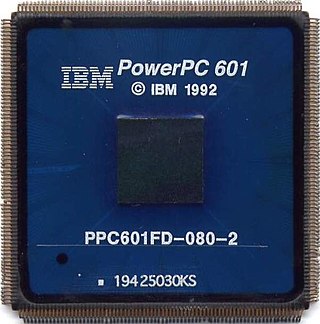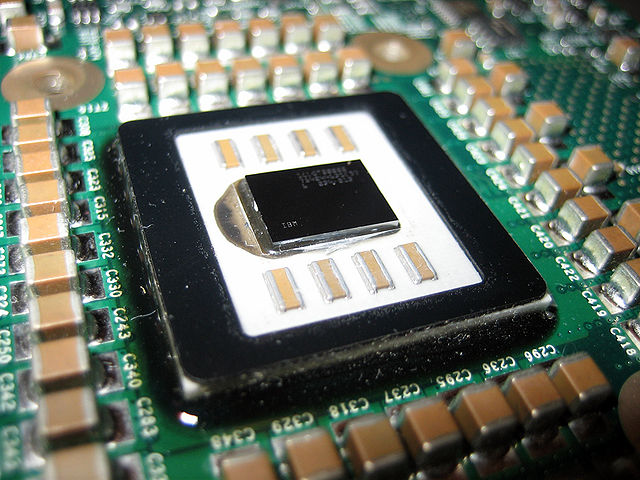Top Qs
Timeline
Chat
Perspective
List of Mac models grouped by CPU type
From Wikipedia, the free encyclopedia
Remove ads
This list of Mac models grouped by CPU type contains all central processing units (CPUs) used by Apple for their Mac computers. It is grouped by processor family, processor model, and then chronologically by Mac models.
Motorola 68k
Summarize
Perspective
Motorola 68000

The Motorola 68000 was the first Apple Macintosh processor. It has 32-bit CPU registers, a 24-bit address bus, and a 16-bit data path; Motorola referred to it as a "16-/32-bit microprocessor."[1]
Motorola 68020

The Motorola 68020 was the first 32-bit Mac processor, first used on the Macintosh II. The 68020 has many improvements over the 68000, including an instruction cache, and was the first Mac processor to support a paged memory management unit, the Motorola 68851.
The Macintosh LC configured the 68020 to use a 16-bit system bus with ASICs that limited RAM to 10 MB (as opposed to the 32-bit limit of 4 GB).
Motorola 68030

The Motorola 68030 was the first Mac processor with an integrated paged memory management unit, allowing for virtual memory. Another improvement over the 68020 was the addition of a data cache.
Motorola 68040

The Motorola 68040 has improved per-clock performance compared to the 68030, as well as larger instruction and data caches, and was the first Mac processor with an integrated floating-point unit.
The MC68LC040 version was less expensive because it omitted the floating-point unit.
Remove ads
PowerPC
Summarize
Perspective
PowerPC 601

The PowerPC 601 was the first Mac processor to support the 32-bit PowerPC instruction set architecture.
PowerPC 603

PowerPC 604

The PowerPC 604e was the first Mac processor available in a symmetric multiprocessing (SMP) configuration.
PowerPC G3

PowerPC G4

The PowerPC 7400 was the first Mac processor to include an AltiVec vector processing unit.
The PowerPC 7455 was the first Mac processor over 1 GHz.
PowerPC G5

The PowerPC 970 ("G5") was the first 64-bit Mac processor.
The PowerPC 970MP was the first dual-core Mac processor and the first to be found in a quad-core configuration. It was also the first Mac processor with partitioning and virtualization capabilities.
Apple only used three variants of the G5, and soon moved entirely onto Intel architecture.
Remove ads
Intel x86
Summarize
Perspective
Sources: Mac Benchmarks - Geekbench Browser, retrieved 2022-05-26 and Haslam, Karen, Which Mac processor? Apple processor comparison: M1 vs Intel, retrieved 2022-05-26
Overview
P6
Yonah was the first Mac processor to support the IA-32 instruction set architecture, in addition to the MMX, SSE, SSE2, and SSE3 extension instruction sets.
The Core Solo was a Core Duo with one of the two cores disabled.
Core
Woodcrest added support for the SSSE3 instruction set.
Merom was the first Mac processor to support the x86-64 instruction set, as well as the first 64-bit processor to appear in a Mac notebook.
Clovertown was the first to be found in an 8-core configuration.
Penryn

Penryn added support for a subset for SSE4 (SSE4.1).
Nehalem

Bloomfield and Gainestown introduced a number of notable features for the first time in any Mac processors:
- Integrated memory controllers (with on-die DMI or QPI).
- Simultaneous multithreading (branded as Hyper-threading).
- Full support for the SSE4 instruction set (SSE4.2).
- Support for Intel Turbo Boost.
- Four cores on a single die rather than a multi-chip module of two dual-core dies.
Westmere
Arrandale introduced Intel HD Graphics, an on-die integrated GPU.
Sandy Bridge

Sandy Bridge added support for Intel Quick Sync Video, a dedicated on-die video encoding and decoding core. It was also the first quad-core processor to appear in a Mac notebook.
Ivy Bridge
Haswell
The Crystal Well variant used in some MacBook Pros contains an on-package L4 cache shared between the CPU and integrated graphics.
Broadwell
Skylake

Kaby Lake
Coffee Lake
Coffee Lake was the first 6-core processor to appear in a Mac notebook.
Cascade Lake
Comet Lake
Ice Lake
Ice Lake (Sunny Cove) is a 10th generation chip.
Remove ads
Apple silicon
Summarize
Perspective
Source: Haslam, Karen, Mac processor comparison: Apple Silicon vs Intel, retrieved 2022-05-26
M1

The M1 is a system on a chip fabricated by TSMC on the 5 nm process and contains 16 billion transistors. Its CPU cores are the first to be used in a Mac processor designed by Apple and the first to use the ARM instruction set architecture. It has 8 CPU cores (4 performance and 4 efficiency), up to 8 GPU cores, and a 16-core Neural Engine, as well as LPDDR4X memory with a bandwidth of 68 GB/s.
The M1 Pro and M1 Max SoCs have 10 CPU cores (8 performance and 2 efficiency) and a 16-core and 32-core GPU, respectively.[20] Both chips were first introduced in the MacBook Pro in October 2021.[21]
The M1 Ultra is a processor combining two M1 Max chips in one package.[22] It was available in the highest-end variants of the Mac Studio, released on March 18, 2022. All parameters of the M1 Max are doubled in M1 Ultra processors; they are, however, packed as one processor package (larger than a Socket AM4 AMD Ryzen processor)[22] and seen as one processor in macOS.
M2
The M2 is a system on a chip fabricated by TSMC on an enhanced 5 nm process, containing 20 billion transistors. It has 8 CPU cores (4 performance and 4 efficiency), up to 10 GPU cores, and a 16 core Neural Engine, as well as LPDDR5 memory with a bandwidth of 100 GB/s.
The M2 Pro and M2 Max have 12 CPU cores (8 performance and 4 efficiency), and a 19-core and 38-core GPU respectively. Both chips were first introduced in the MacBook Pro in January 2023.[23]
The M2 Ultra is a processor combining two M2 Max dies in one package. It is available in the highest-end variants of the Mac Studio as well as the Mac Pro, both released on June 13, 2023.[24]
M3
The M3 is a system on a chip fabricated by TSMC on the 3 nm process, containing 25 billion transistors. It has 8 CPU cores (4 performance and 4 efficiency), up to 10 GPU cores, and a 16 core Neural Engine, as well as LPDDR5 memory with a bandwidth of 100 GB/s.
The M3 Pro has 12 CPU cores (6 performance and 6 efficiency), while the M3 Max has 16 CPU cores (12 performance and 4 efficiency); they have an 18-core and 40-core GPU respectively. Both chips were first introduced in the MacBook Pro in October 2023.[25]
The M3 Ultra is a processor combining two M3 Max dies in one package. It is available in the highest-end variants of the Mac Studio, released on March 12, 2025.[26]
M4
The M4 is a system on a chip fabricated by TSMC on an enhanced 3 nm process, containing 28 billion transistors. It has up to 10 CPU cores (4 performance and 6 efficiency), up to 10 GPU cores, and a 16 core Neural Engine, as well as LPDDR5X memory with a bandwidth of 120 GB/s.
The M4 Pro has 14 CPU cores (10 performance and 4 efficiency), while the M4 Max has 16 CPU cores (12 performance and 4 efficiency); they have a 20-core and 40-core GPU respectively. Both chips were first introduced in the MacBook Pro in October 2024.[27]
M5
The M5 is a system on a chip fabricated by TSMC on a third-generation 3 nm process. It has up to 10 CPU cores (4 performance and 6 efficiency), up to 10 GPU cores, and a 16 core Neural Engine, as well as LPDDR5X memory with a bandwidth of 153 GB/s. It was first introduced in the MacBook Pro in October 2025.[28]
Remove ads
See also
Notes
- Included due to its compatibility with Macintosh software and common use as an early Macintosh development platform.
- Retroactively named the "Macintosh 128K" after the release of the Macintosh 512K.
- An Apple Lisa modified with MacWorks XL to run Mac software.
- Sold in educational markets as the "Macintosh Plus ED."
- Sold in educational markets as the "Macintosh ED."
- Shipped with A/UX operating system but capable of running Mac OS.
- Sold in Europe and Asia as the "Power Macintosh 6300/160."
- Teardowns indicate that it used an under clocked Dothan-based Pentium M ULV processor,[citation needed] called "Crofton" by Intel.[17]
- Uses an ultra low-voltage processor previously branded as Core M.
Remove ads
References
Sources
Wikiwand - on
Seamless Wikipedia browsing. On steroids.
Remove ads